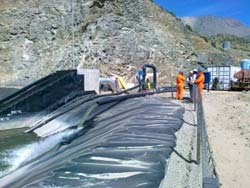Treatment for Wastewater in Open-pit Mines

As the operators can reuse the treated water, the mine requires less water. The wastewater produced by mines is in parts very acidic which contributes to the extraction of metals. The processing plant can treat the most part of the mine's wastewater. A pilot plant for the new treatment technology is installed at a copper mine in Chile.
Everyday, copper mines use tens of thousands of cubic meters of water – some mines even use over one hundred thousand. This corresponds to the water consumption of a medium sized city. Many mines cannot expand their production because they do not have enough water.
Mine operators in Chile are building desalination facilities for sea water and are pumping the valuable water from the coast to the mining regions, which are located at an altitude of 3,000 meters. The wastewater is used to transport fine grain residues to big reservoirs. Increasing water shortages and stringent environmental regulations are forcing mine operators to think about treating and reusing the wastewater.
Siemens is exploiting this trend and is transferring tested processes from the treatment of drinking water to the mines. In the mobile pilot plant, the contaminated water is passed through two treatment stages:
First a micro filters remove particles that are bigger than a thousandth of a millimeter. In the next stage – nanofiltration – the water is passed through a membrane with nanopores so that nearly all pollutants are separated from the water. What is left is pure water of a high quality and a concentrated solution of the contaminants, which must then be disposed of.
The throughput of the pilot plant is nearly 100 cubic meters of water per day – a fraction of the wastewater produced by a mine. Siemens uses the plant to demonstrate the process and to analyze the wastewater produced by a mine, as the composition of each mine's wastewater is different. The data gained by the pilot plant serves as the foundation for the design of the actual treatment facility.
Siemens has been cooperating with the Technical University Bergakademie Freiberg for some years to research innovative concepts for the treatment of wastewater from mines. As the company with the largest environmental portfolio worldwide, which generated sales of approximately €30 billion in fiscal 2011, Siemens can and will make a major contribution in this area.
Media Contact
More Information:
http://www.siemens.com/innovationnewsAll latest news from the category: Ecology, The Environment and Conservation
This complex theme deals primarily with interactions between organisms and the environmental factors that impact them, but to a greater extent between individual inanimate environmental factors.
innovations-report offers informative reports and articles on topics such as climate protection, landscape conservation, ecological systems, wildlife and nature parks and ecosystem efficiency and balance.
Newest articles

Bringing bio-inspired robots to life
Nebraska researcher Eric Markvicka gets NSF CAREER Award to pursue manufacture of novel materials for soft robotics and stretchable electronics. Engineers are increasingly eager to develop robots that mimic the…

Bella moths use poison to attract mates
Scientists are closer to finding out how. Pyrrolizidine alkaloids are as bitter and toxic as they are hard to pronounce. They’re produced by several different types of plants and are…

AI tool creates ‘synthetic’ images of cells
…for enhanced microscopy analysis. Observing individual cells through microscopes can reveal a range of important cell biological phenomena that frequently play a role in human diseases, but the process of…





















